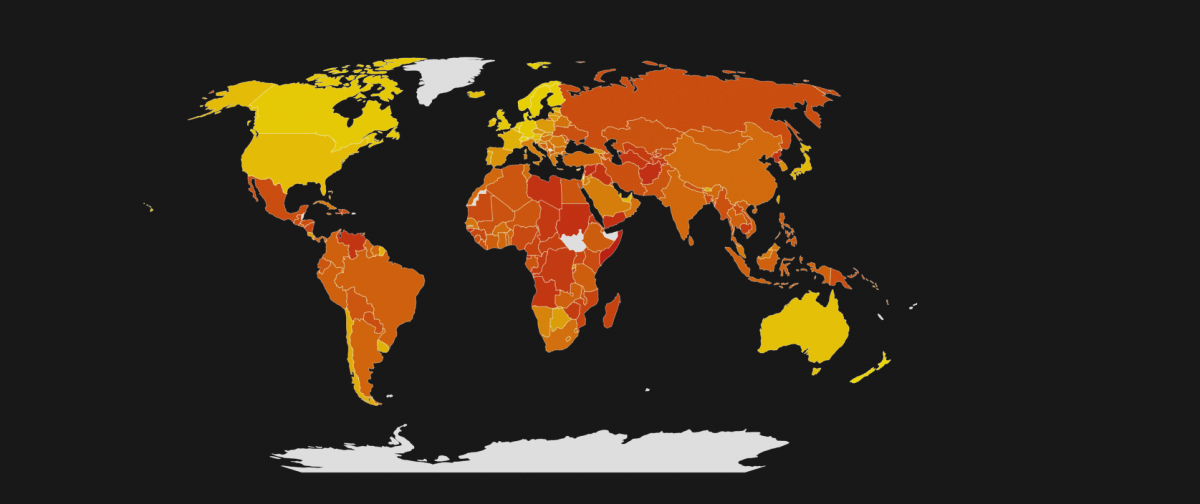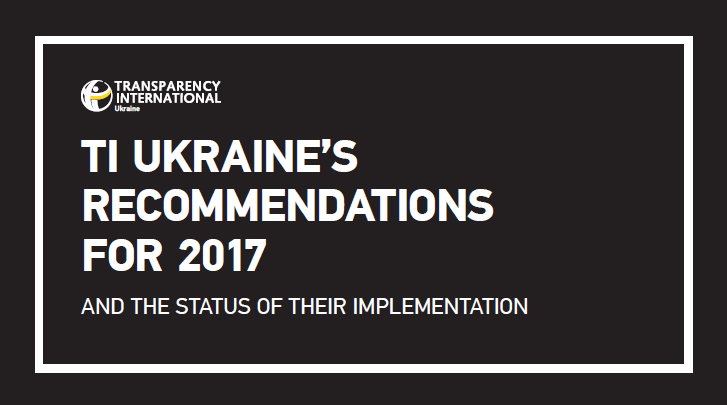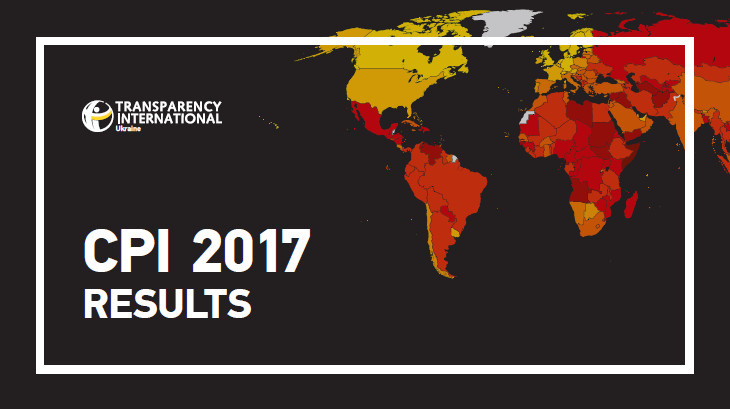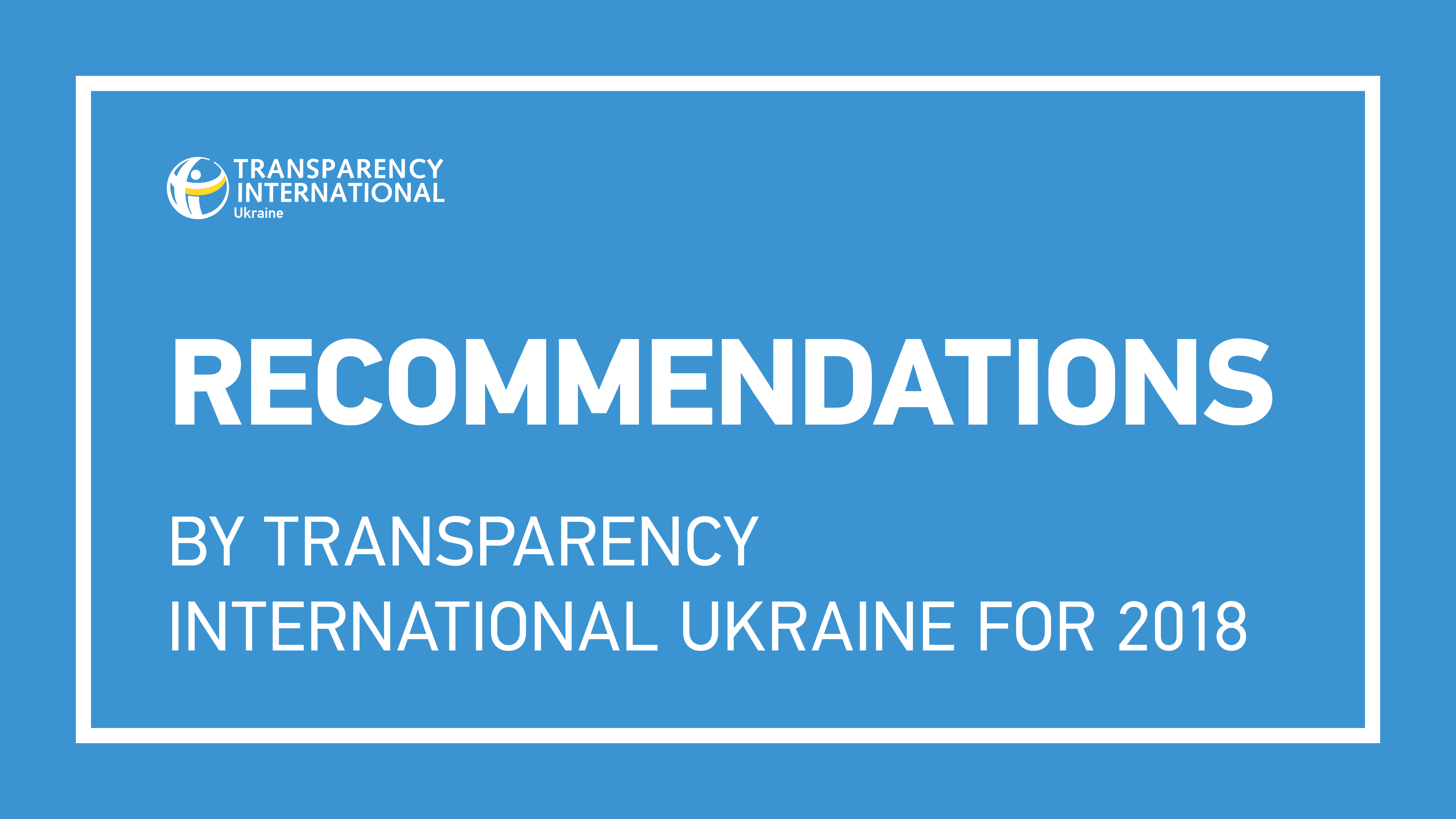

In 2017, Ukraine received 30 out of 100 points in the Corruption Perceptions Index, an annual study by Transparency International, ranking 130th out of 180 countries. It is one point and one place up from last year (29 points, rank 131 out of 176 countries). When it comes to the dynamics, though, last year’s results are not as good as in 2016 (2 points of growth vs. 1 point).
Interactive Infographic in Ukrainian
Transparency International’s results brochure
Among the reasons which helped Ukraine move up to a higher position are the following. Anti-corruption bodies (SAP/NABU) carried out their investigative work in 2017, sending first suspicion of grand corruption cases to the court. The register of electronic declarations continued its work. Public procurement system reform and requirement to use the ProZorro system celebrated the first anniversary. Gas market was reformed. Ukraine also made some positive steps towards deregulation.
Authors of studies the Index is based on also noted the reduction of police corruption and number of cases when business was coerced into bribery.
On the other hand, Ukraine’s slow growth in the Index, effective reduction of the growth dynamics by half, is down to such circumstances as lack of political will of the country’s government for a resolute fight against corruption as well as a low level of trust for Ukrainian courts and prosecution. Another point that cannot be overlooked is the regular legislative initiatives put forward by the parliament which threaten the newly created anti-corruption infrastructure. As the result, corruption remains among the most acute problems faced by business and regular citizens.
Last year’s recommendations provided by Transparency International Ukraine were only implemented partly. For instance, the launch of the High Anti-Corruption Court in 2017 halted at the stage of submission of a President-initiated draft law contradictory to recommendations of the Venice Commission. “Yanukovych’s funds” were transferred to the national budget based on a questionable court decision which remains officially classified. The government made some progress towards development of the progressive eHealth system, launched the procedure of automatic VAT return, yet the year brought numerous legislative initiatives which could have destroyed the ProZorro system. Draft law “Buy Ukrainian, Pay Ukrainians,” which enables corruption in public procurement, was supported in the first reading. Audit of defense procurement is yet to happen, while the high level of secrecy in this sector remains unfounded. There were also numerous attempts to restrict the independence of newly created anti-corruption bodies and instances of pressure on journalists and activists who work with corruption counteraction, such as the discriminatory requirement to submit property e-declarations, pressure from law enforcement agencies, provocations, opposition, beatings, and defamatory campaigns.
In the 2017 CPI, it was the first time since 2010 Ukraine beat Russia (29 points), which did not improve its rank over last year. The results of other neighboring countries are still higher than Ukraine’s: Poland – 60 points, Slovakia – 50, Romania – 48, Hungary – 45, Belarus – 44, Moldova – 31.
Transparency International Ukraine recommends to take the following measures to improve the results in 2018:
- Launch the High Anti-Corruption Court and continue the court reform
(Pass the law on the Anti-Corruption Court compliant with the recommendations of the Venice Commission. Launch the Anti-Corruption Court in 2018 and ensure its independence of any influence. Improve the transparency of the selection process of judges, giving the public greater influence in the qualification assessment of judges)
- Strengthen the capability of investigative bodies and stop the interagency fight
(Pass legislation concerning reinforcement of powers of SAP/NABU, provide NABU detectives with the right of independent tapping missions. Stop destructive public confrontation of heads of law enforcement agencies and pressure on journalists and activists working in this area)
- Reset the NAPC
(Pass legislation which will enable NAPC reset on the conditions of a transparent and independent competition. Provide legislative framework for quality cooperation and protection of corruption whistleblowers. Ensure complete and unimpeded functioning of the register of e-declarations. Introduce automatic verification of declarations and intensify verification of top officials’ declarations)
- Introduce new electronic state information systems
(Extend the ProZorro principle of “everyone sees everything” to new areas of interaction of the state, the society and business. “Digitalize” and automate the interaction between the business and the State Fiscal Service as much as possible)
- Deprive law enforcement agencies of the right to interfere with economic activity
(Change legislation concerning the National Police and the Security Service of Ukraine, abolishing their right to investigate economic crimes. Provide the legislative framework for and create the Financial Investigation Service)
FOR REFERENCE:
Corruption Perceptions Index 2017, СРІ is a research by the anti-corruption network Transparency International, first compiled in 1995. The CPI is the most widely used indicator of corruption worldwide.
The 2017 CPI draws on 13 data sources from 12 independent institutions
specializing in governance and business climate analysis. The sources of information used for the 2017 CPI are based on data published in the previous two years. The CPI includes only sources that provide a score for a set of countries/territories and that measure expert perceptions of corruption in the public sector. Transparency International reviews the methodology of each data source in detail to ensure that the sources used meet Transparency International’s quality standards.
A country/territory’s score indicates the perceived level of public sector corruption on a scale of 0-100, where 0 means that a country is perceived as highly corrupt and a 100 means that a country is perceived as very clean. A country’s rank indicates its position relative to the other countries/territories included in the index.










